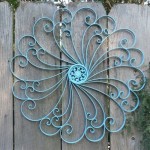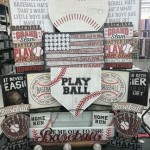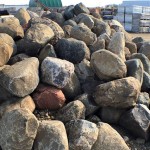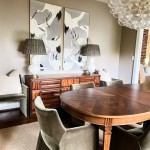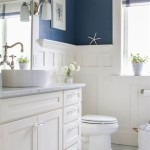How To Decorate a Home Bar: Creating an Inviting and Stylish Space
A home bar offers a dedicated area for entertaining, relaxing, and enjoying beverages in a personalized setting. Decorating a home bar effectively requires careful consideration of space, style, and functionality. The following guidelines provide a structured approach to planning and executing a bar design that is both aesthetically pleasing and practical.
1. Assessing Space and Defining Layout
Before embarking on any decorative endeavors, accurately assess the available space. Measure the length, width, and height of the designated area to understand its limitations and potential. Consider the existing architectural features of the room, such as windows, doors, and built-in elements. These features will significantly influence the bar's layout and design.
Once the spatial dimensions are established, determine the desired functionality of the bar. Will it primarily serve as a cocktail-making station, a wine-tasting area, or a general entertainment hub? Identifying the primary purpose will dictate the necessary equipment and storage solutions. For instance, a cocktail-focused bar might require ample counter space for mixing drinks, while a wine bar would benefit from specialized wine racks and a temperature-controlled storage unit.
Several layout options can be considered, depending on the available space and desired functionality. A linear bar, positioned along a wall, is a common and space-efficient choice. An L-shaped bar offers increased counter space and allows for better interaction with guests. An island bar, situated in the center of the room, creates a focal point and provides ample seating options. A portable bar, often on wheels, provides maximum flexibility and can be easily relocated as needed. The chosen layout should optimize workflow, maximize storage, and encourage social interaction.
Consider the traffic flow around the bar area. Ensure sufficient space for people to move comfortably without obstructing access to other parts of the room. The placement of seating should allow for easy conversation and prevent overcrowding. Strategic placement of lighting can also influence traffic flow, guiding people toward the bar and creating a welcoming atmosphere.
2. Selecting a Design Style and Palette
The design style of the home bar should complement the overall aesthetic of the home. Consistency in design creates a cohesive and harmonious living environment. Popular design styles for home bars include modern, classic, rustic, industrial, and eclectic. Each style possesses distinct characteristics that influence the selection of materials, colors, and accessories.
A modern bar typically features clean lines, minimalist décor, and a focus on functionality. Common materials include stainless steel, glass, and sleek wood finishes. The color palette often consists of neutral tones, such as gray, white, and black, with occasional pops of vibrant color. Classic bars evoke a sense of elegance and sophistication, often incorporating traditional materials like dark wood, leather, and brass. The color palette typically includes rich hues such as burgundy, navy, and emerald green. Rustic bars emphasize natural materials and a relaxed, informal atmosphere. Wood is a primary element, often with a distressed or reclaimed finish. Colors tend to be warm and earthy, such as brown, beige, and olive green. Industrial bars showcase raw materials and a utilitarian aesthetic. Exposed brick, metal pipes, and concrete are common features. The color palette is typically muted, with grays, blacks, and browns dominating. Eclectic bars offer the opportunity to combine elements from different styles, creating a unique and personalized space. This style allows for greater freedom in color choices and material selection.
The color palette of the bar should be carefully considered, taking into account the existing colors in the room and the desired atmosphere. Dark colors can create a cozy and intimate setting, while light colors can make the space feel more open and airy. Accent colors can be used to add visual interest and highlight specific features, such as artwork or glassware. Consider the psychological impact of different colors. Blue is often associated with relaxation, while red is associated with energy and excitement. Choose colors that align with the intended mood of the bar.
Material selection is an essential aspect of decorating a home bar. Countertops, backsplashes, and flooring materials significantly impact the bar's overall appearance and durability. Common countertop materials include granite, marble, quartz, and wood. Granite and quartz are durable and stain-resistant, making them ideal for high-traffic areas. Marble provides a luxurious aesthetic but requires more maintenance. Wood adds warmth and character but is susceptible to water damage. Backsplashes can be made from tile, glass, or metal. Tile offers a wide range of design options and is easy to clean. Glass adds a touch of elegance and reflects light, making the space feel brighter. Metal provides a modern and industrial look. Flooring options include hardwood, tile, and laminate. Hardwood is a classic choice that adds warmth and character. Tile is durable and water-resistant, making it ideal for areas prone to spills. Laminate is a budget-friendly option that mimics the look of hardwood or tile.
3. Incorporating Functional and Decorative Elements
Functional elements are essential for the efficient operation of the bar. These elements include storage solutions, lighting fixtures, and bar equipment. Storage solutions should be carefully planned to accommodate bottles, glassware, bar tools, and other essential items. Cabinets, shelves, and drawers provide organized storage and keep the bar area clutter-free. Wine racks can be used to store wine bottles horizontally, preventing corks from drying out. Glassware racks can be installed above the bar to display and store glasses. Consider incorporating a small refrigerator or wine cooler to keep beverages chilled.
Lighting is crucial for creating the desired ambiance in the bar. Ambient lighting provides general illumination, while task lighting illuminates specific areas, such as the countertop. Accent lighting highlights decorative features, such as artwork or collectibles. Dimmable lighting allows for adjusting the brightness to suit different occasions. Pendant lights are a popular choice for illuminating the bar countertop, while recessed lighting provides a clean and modern look. Consider incorporating LED strip lights under the bar counter or shelves to add a touch of drama.
Bar equipment is essential for preparing and serving drinks. A basic set of bar tools includes a shaker, jigger, muddler, bar spoon, and strainer. A bottle opener and corkscrew are also essential. Consider investing in a blender for making frozen cocktails and a citrus juicer for fresh juices. Displaying bar tools and equipment in an organized and aesthetically pleasing manner can enhance the overall appearance of the bar.
Decorative elements add personality and visual interest to the home bar. These elements include artwork, mirrors, plants, and accessories. Artwork can be used to create a focal point and reflect the bar's design style. Mirrors can make the space feel larger and brighter. Plants add a touch of nature and freshness. Accessories such as decorative bottles, coasters, and cocktail napkins can add a personal touch. Consider incorporating themed decorations to reflect personal interests or hobbies. For example, a sports-themed bar might feature framed jerseys or memorabilia, while a travel-themed bar could display maps and souvenirs.
Personalizing the bar with unique and meaningful items can create a welcoming and inviting atmosphere. Displaying favorite bottles of liquor or wine adds a personal touch. Incorporating vintage barware or antique accessories can add character and history. Creating a signature cocktail menu and displaying it on a chalkboard or framed print adds a personalized touch. Ultimately, the goal is to create a space that reflects personal style and interests, making it a comfortable and enjoyable place to relax and entertain.
Seating is also a crucial element of a home bar. Bar stools are a classic choice, providing comfortable seating at the bar counter. Choose stools that are the appropriate height for the counter to ensure comfortable seating. Consider incorporating armrests and footrests for added comfort. Other seating options include lounge chairs, sofas, and banquettes. These options provide more relaxed seating for larger groups. The placement of seating should allow for easy conversation and movement around the bar area.
Finally, consider the acoustics of the bar area. Hard surfaces, such as tile and glass, can reflect sound and create an echo. Soft surfaces, such as rugs and upholstered furniture, can absorb sound and reduce echo. Consider incorporating acoustic panels or sound-absorbing materials to improve the acoustics of the bar. This will create a more comfortable and enjoyable environment for conversation and entertainment.

30 Beautiful Home Bar Designs Furniture And Decorating Ideas Decor Bars For

12 Ways To Display Your Home Bar And Kitchen Review Bars For Diy Decor

How To Decorate A Bar
:max_bytes(150000):strip_icc()/6a00d8358081ff69e201a3fcfd6671970b-800wi-e5562c915e1b4a168a37d683de774132.jpg?strip=all)
55 Home Bar Ideas That Bring The Party To You

Home Bar Design Latest Trends In Upscale Bars At

Basement Bar Ideas And Designs Diy Home Rooms

17 Colorful Home Bar Ideas Fun Designs For Small Bars

15 Home Bar Ideas For The Perfect Design Family Handyman

68 Modern Home Bar Ideas To Elevate Small Spaces
35 Outstanding Home Bar Ideas And Designs Renoguide N Renovation Inspiration

